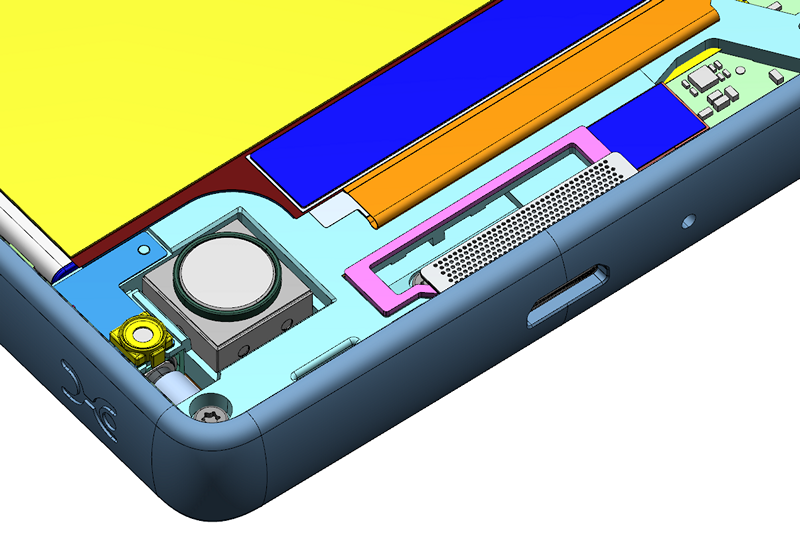Smartphone Camera and Layout Difficulties

Hello, Habr. The layout of modern smartphones is extremely dense. For which only tricks the developers do not have to go in order to effectively use each cubic millimeter of volume, fitting a multitude of components and parts into more than compact cases. And after all, you need not just to pack tightly all the necessary elements, you need to constantly remember about the effective heat sink. Moreover, when choosing components, one always has to find a compromise between quality, price, technical parameters, and - physical size.
The struggle for volume is not for life, but for death. And when developing the first YotaPhone, we had a particularly difficult time with the placement of the camera, because we did not want to use a more compact, but less quality model.
Volume matters
Smartphones are getting thinner - naturally, this is not happening by itself. Electronic components gradually evolve, decrease in thickness, length and width, become energy-efficient. And this allows engineers year after year to systematically reduce the thickness of the gadgets.
')
Unfortunately, sometimes there are situations when a particular node or component does not physically fit into the right place. In such cases, you have to "push" the surrounding elements, use other types, change the design of the device. In smartphones, cameras like this are often “sinned”. Pay attention to how many around the models of smartphones, in which the lenses of cameras somewhat protrude beyond the body. This is not at all a whim of designers, not a manifestation of originality. It's just the engineers could not "drown" the camera module inside the case, or it was not possible to use a more compact version.
I must say that some users do not like speakers too much. If the lens is not located on the vertical axis of the smartphone, then on a flat solid surface the device will lie a bit “inharmoniously”. And someone can bring this fact to a white-hot:
Our experience
When developing the first YotaPhone, we also had to solve all sorts of layout problems. Given the availability of a second display, we were extremely limited in the availability of free space on the back wall for the camera. The model chosen by us possessed good technical parameters and provided high quality of shooting. But the camera had one small drawback - it was quite large. And fit it into the top of the smartphone categorically did not work. All sorts of options were tried, they tried to place other nodes in different ways, but nothing came of it. A large module rather strongly protruded outside the case, completely destroying the design of the smartphone.
Dimensions of the camera module assembly:


The camera lens consists of 5 optical elements, aperture 2.2, field of view 70.6 degrees diagonally. The diameter of the lenses reaches almost 5 mm, the shutter speed range of the electronic shutter is from 1/15 to 1/10 000 seconds. Focusing is done by moving the lens inside the lens.
We were faced with a choice: either use a compact and lower quality camera module, or move the camera to another location. We considered the worst quality camera unworthy, as well as disrupting the cleanliness of the body lines by the influx of the lens. And we went to a non-standard step - placed the camera in a rather unexpected place, in the lower left corner of the smartphone.


Thanks to this layout, the YotaPhone does not protrude from the enclosure. Therefore, the smartphone is tactilely pleasant, nothing “clings”, on the table it lies firmly and steadily with any manipulations.
Promising technology
We are constantly looking for new technologies that could be effectively used in our products. Moreover, we are equally interested in the developments aimed at both the qualitative improvement of certain properties and the optimization of the use of the available volume. This is especially important for us, given the presence of a second display with its own hardware strapping. And with the “standard” set of components we have a hard time, and in our case one more rather volumetric node is added. And all this needs to be effectively “tamped” into the body of a modern stylish and fairly compact smartphone, showing miracles of fiction.
Therefore, along with many other developments, we were interested in the idea of the company DynaOptics . Last week, she presented a working prototype of an optical circuit that will make cameras for smartphones much more compact without sacrificing their capabilities. The developers have set themselves the task of preserving the possibility of optical zoom, which is much more preferable from the point of view of photo quality as compared to software zoom. And that's what they came up with:

In traditional lenses, the focal length (zoom) changes due to the movement of the lens (lenses), and this requires some space. The developers of DynaOptics suggest using asymmetrical lenses, which can be positioned closer to each other, and the focal length can be changed by moving perpendicular to the longitudinal axis of the lens, rather than parallel. The first engineering samples can be manufactured in the first quarter of next year, and by the end of 2015, developers are planning to prepare mass production of components.
In our opinion, the idea is very interesting and viable. It is unlikely that the production of such asymmetric lenses will be particularly difficult, given their more than modest size. Rate, for example, the complexity of creating lenses for full-size cameras:
Source: https://habr.com/ru/post/238275/
All Articles